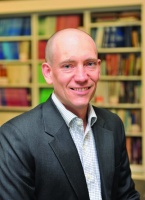Peter Young, UK head of Arup Advanced Technology & Research
Measured advice: Arup’s UK technology chief has a brief stretching way beyond his firm’s structural heartland.

You can tell you’re in an engineering practice as soon as you step into Arup’s offices. Of course, the meticulous model of the streetscape around St Paul’s Cathedral and the pictures of bridges and buildings, all cool geometry and shining materials, are good clues, but what really gives it away are the lifts. Rather than just an up or down button, the control panels ask you which floor you want when you call the lift. When it arrives, the floor panel in front of the doors lights up.
’It makes complete sense,’ said Peter Young, UK head of the civil engineering firm’s Advanced Technology and Research (AT+R) division. ’The lift system can plan when it sends the lifts down and makes sure the floor visits are planned out in the optimum order, so nobody waits longer than required.’
It’s the sort of oblique-thinking attention to detail that Arup likes to project into the world, and Young, whose shaven head and measured way of speaking give him the stripped-down aspect of many of the company’s trademark structures, carries through that impression. A specialist in analysing and countering vibration in structures, Young’s early work with Arup included working on the scheme to dampen the infamous ’wobble’ in London’s Millennium Bridge, the pedestrian river crossing linking St Paul’s with Tate Modern. Since then he’s worked on many vibration-damping systems, for buildings in earthquake zones and for tall structures vulnerable to the buffeting of the wind.
Register now to continue reading
Thanks for visiting The Engineer. You’ve now reached your monthly limit of premium content. Register for free to unlock unlimited access to all of our premium content, as well as the latest technology news, industry opinion and special reports.
Benefits of registering
-
In-depth insights and coverage of key emerging trends
-
Unrestricted access to special reports throughout the year
-
Daily technology news delivered straight to your inbox










Water Sector Talent Exodus Could Cripple The Sector
Well let´s do a little experiment. My last (10.4.25) half-yearly water/waste water bill from Severn Trent was £98.29. How much does not-for-profit Dŵr...